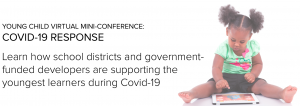Superintendents Brainstorm to Support Early Learners During COVID-19 Outbreak

Opinion
As school closures continue due to the COVID-19 outbreak, we are moving from triage to trying to solve longer-term issues in our early education systems.
Thankfully, early childhood educators are generously sharing their successes (and failures) to help their peers provide effective solutions to problems that have caught most everyone unprepared. Recently my organization coordinated a free virtual mini conference for educators titled “Learn How School Districts and Government-Funded Developers Are Supporting The Youngest Learners During COVID-19.”
The event attracted 3,000 registrants across all 50 states, and an average of 1,500 people were online attending the conference at any given moment. The audience was largely composed of practitioners–55 percent were early childhood educators and 20 percent were school/program administrators. There were also registrants from the federal level and across 16 state governments.
The four-hour virtual event was divided into three main segments, each with valuable information and takeaways.
1. Early Childhood School Leader Panel
The event began when Mort Sherman, associate executive director of AASA (The School Superintendents Association), moderated a panel of K-12 superintendents from a diverse set of districts.
The first topic addressed by the panelists was “If we can’t address basic needs, there is no learning.”
Michael Hynes, superintendent of the Port Washington Union Free School District, right outside of New York City, described how his district had to work at understanding trauma, not only with students and parents, but also among teachers. Resources they have used to inform their new practices include Adverse Childhood Experiences (ACEs) and Maslow’s hierarchy of needs.
Michael Kuhrt, superintendent of the Wichita Falls Independent School District in Texas said his school system is acting more as a social services organization right now. District leaders are taking care of families—and teachers—in many ways, including feeding students and connecting families to funding for rent and electricity.
Pia Escudero, the executive director of the Division of Student Health and Human Services at the Los Angeles Unified School District, described how the district established a hotline within 24 hours of school closures to address issues concerning food, shelter, and mental health crises. L.A. Unified is the second-largest district in the country, covering 700 square miles, where 99 different languages are spoken. Before COVID-19, 86 percent of children qualified for free and reduced-price lunch and 18,000 students were homeless. As of May 5, the district had opened up 65 “grab-and go” food sites, distributing 20 million meals so far.
Sherman, of AASA, then kicked off a discussion on the topic of loss of learning by noting that early learners are different. You can’t put them in front of a device like you can with older children.
Hynes said his district is focusing on creativity and self-directed play to find balance between structured and unstructured learning time.
Chandra Youngblood, the director of elementary education at the Battle Creek school district in Michigan acknowledged that educators are asking parents to do a lot. Training for parents is a topic her staff is addressing. She is interested in platforms and tools that can help connect teachers and parents. The district’s literacy tutors are poised to jump in right at the beginning of kindergarten to address the loss of learning once school starts up again. They are also surveying parents to determine interest in educational programs and support over the summer.
All five school leader panelists said they expect to see substantial budget cuts. They are looking for new ways to collaborate with organizations and the community, and find other funding partners and foundations to help address funding gaps.
Edward Manuszak, the superintendent of the Dundee Community Schools in Michigan said superintendents in his state have been alerted to expect a funding cut of $500 to $1000 per student over the next 18 months.
Youngblood’s district issued a stop on all spending from the general fund as of early May. Hynes said that New York State is predicting a $15 billion budget deficit, which could result in at least a 20 percent budget reduction in state aid. That loss of funding will be cataclysmic, especially for the most needy school districts, he said, highlighting the need to reserve money now to accommodate re-entry plans that might include equipment purchases such as masks.
The AASA’s Early Learning Cohort offers a number of opportunities for district leaders to continue the conversation about supporting our youngest learners in these times—and beyond.
2. Lightning Talks
In 15-minute segments, government-funded developers highlighted free early childhood products and services they are providing to support remote instruction for the rest of the school year, including testimonials and case studies.
Companies were all funded by the Small Business Innovation Research programs at the U.S. Department of Education’s Institute of Education Sciences and the National Science Foundation, as well as other programs. The tools and resources offered addressed broad themes around supporting teacher/family engagement, STEM, and social-emotional development. These and other resources are being tracked and published by the U.S. Department of Education’s Inside IES Research blog.
3. Closing Remarks
Deborah Bergeron, the director of the Office of Head Start at the U.S. Department of Health and Human Services, Administration for Children & Families, ended the conference on an upbeat note, citing a few positive takeaways:
- This virtual meeting attracted a broad audience who otherwise might not have been able to attend a similar in-person event.
- The urgency of solving the problem of inequity in digital access is finally being addressed, with more families receiving devices and internet connectivity than ever before.
- School administrators are recognizing the value of establishing strong relationships with families.
No More Business as Usual
 One common theme running through all segments was that we shouldn’t want to return to “normal.” These times, difficult as they may be, provide an opportunity to emerge stronger and better, and not return to business as usual.
One common theme running through all segments was that we shouldn’t want to return to “normal.” These times, difficult as they may be, provide an opportunity to emerge stronger and better, and not return to business as usual.
This sentiment echoes the improvements developers made to their products in response to the crisis. Bergeron noted that Head Start and other programs are developing closer relationships than ever before with K-12 districts, which should lead to successful re-openings and more collaboration in the future. These efforts will ultimately improve the services and education that our youngest learners receive well into the future.
A resource-filled handout is available to download on the conference website.
Follow EdWeek Market Brief on Twitter @EdMarketBrief or connect with us on LinkedIn.
Image courtesy of Cognitive ToyBox.
See also:

Hi, very nice and well written blog. Thanks for sharing! Read more https://threelinks.org/coronavirus-update-march-2-2020/
Its really wonderful article about Early Learners During COVID-19 Outbreak. You may like https://www.bdtechsupport.com/2020/04/coronavirus-tips-and-tricks.html
Hi, very nice and well written blog. Thanks for sharing!